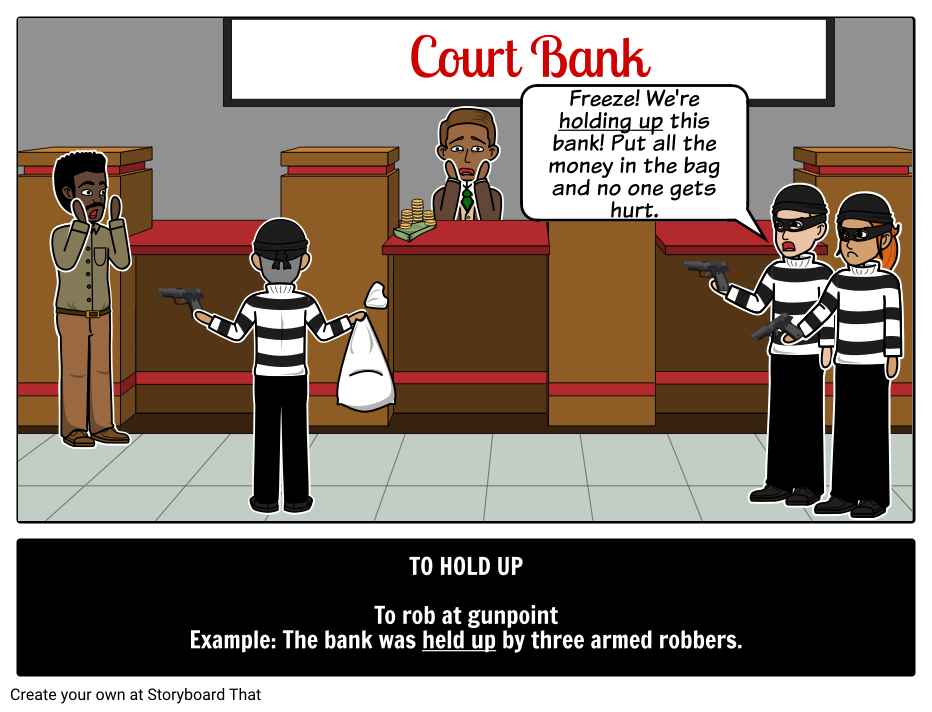Welcome to Storyboard That's Picture Encyclopedia of English Phrasal Verbs! We have put together a collection of storyboards to help you better understand the meaning of phrasal verbs. We hope you enjoy this guide as much as we enjoyed making it, and maybe you will make a few storyboards of your own!
Click on any of the terms below to get started!
How Tos about {lmk:100543}
Guide students in creating their own storyboard for a phrasal verb
Encourage students to pick a phrasal verb from your lesson or the encyclopedia. This empowers them to take ownership of their learning and choose a verb that interests them.
Explain the meaning and usage of the chosen phrasal verb
Discuss the definition and give examples in sentences. Clarifying the meaning helps students understand the context and proper usage of the verb.
Brainstorm real-life scenarios that use the phrasal verb
Ask students to think of situations where the phrasal verb might be used in daily life. This step encourages creative thinking and connects language to personal experience.
Sketch or digitally create a storyboard illustrating the scenario
Have students draw or use a digital tool to create a simple, 3–4 panel storyboard. Visual storytelling helps reinforce understanding and makes learning interactive.
Share and discuss storyboards with the class
Invite students to present their storyboards and explain their thinking. Sharing builds confidence, improves speaking skills, and allows students to learn from each other’s examples.
Frequently Asked Questions about {lmk:100543}
What is a phrasal verb in English?
A phrasal verb is a combination of a verb and one or more particles (prepositions or adverbs) that together create a new meaning, such as "give up" or "look after".
How can teachers use storyboards to teach phrasal verbs?
Teachers can use storyboards to visually represent phrasal verbs in context, making meanings clear and memorable for students by showing examples and scenarios.
Why are phrasal verbs important for English learners?
Phrasal verbs are essential for English learners because they are commonly used in everyday speech and writing, helping students sound more fluent and natural.
What are some common English phrasal verbs students should know?
Some common phrasal verbs include "turn on," "pick up," "find out," "give up," and "run out." Knowing these helps students understand native speakers and texts.
Where can I find visual examples of phrasal verbs for my classroom?
You can find visual examples of phrasal verbs in Storyboard That's Picture Encyclopedia, which uses storyboards to illustrate meanings and usage for students and teachers.
To Add Up - To Hold On
Bring This to Your Classroom!
Our digital picture encyclopedia resources have easy to understand information with a visual in order to activate understanding and retention. Storyboard That is passionate about creating resources that inspire children to be storytellers, and we want students of all ages to have the ability to showcase what they have learned.

- Assign a term/person/event to each student to complete their own storyboard.
- Create your own picture encyclopedia of a topic you are studying.
- Create a picture encyclopedia of the people in your class or school.
- Post storyboards to class and school social media channels.
- Copy and edit these storyboards and encyclopedia pictures and use them as references or visuals.
© 2025 - Clever Prototypes, LLC - All rights reserved.
StoryboardThat is a trademark of Clever Prototypes, LLC, and Registered in U.S. Patent and Trademark Office
